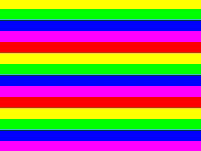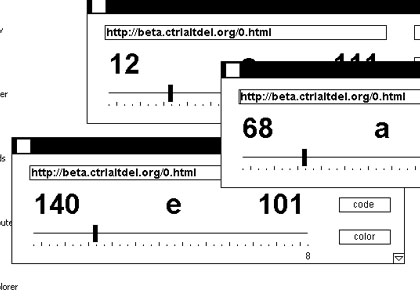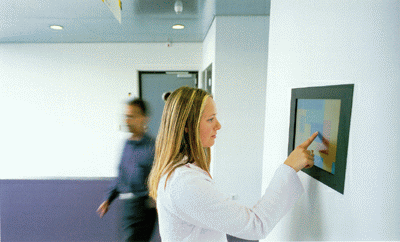 |
[January 24th 2005]

From Peter Luining's touch screen installation test 1934893 b 55 at the show 'Random Access Memory', Lokaal01, Breda, the Netherlands.
Art is a software plug-in.
An interview with Peter Luining
Dutch artist Peter Luining's digital artistic production spans over many styles and formats. Since he entered the early net art scene, his works have explored the nature of interactivity and dealt with the relationship between sound and minimal graphics using various aesthetic, and conceptual perspectives. His works have been presented at several prestigious venues worldwide and he has acted as a curator himself. Peter recently visited Denmark for the Read_me festival 2004 where he presented some new art works consisting of alternative add-ons ('plug-ins') which are installed as a part of the image editing software Photoshop. These plug-ins add unexpected dimensions to the existing software, making the interaction with the software the frame within which the art happens - not so much the resulting images. Thomas Petersen asked Peter about his work in general and his perspective on the digital arts scene.
View Peter Luining's work at: www.ctrlaltdel.org.
You have been working with computer based art for quite a while now. Tell me about your previous work and how it has developed into your present projects.
I started to do autonomous work for the internet in 1996. I was fascinated by the way you could easily make things interactive with html (a language in which web pages are programmed). My first work researched the possibilities of interactive sound and images. These were quite simple pieces; with a click you came to another page on which another sound and animation played. By giving people more choices on a page to navigate, I created more complex works.
 
Screenshots from Clickclub (1996-2001). http://www.ctrlaltdel.org/clickclub
In these early days cross-platform compatibility was the most problematic aspect. When I discovered Flash this seemed to solve the problem. With Flash my work changed from figurative to abstract, which had several reasons, but looking back I would say one of the most decisive reasons for the abstraction was that if you used anything else than the internal vector shapes (blocks, dots, lines) in Flash you would not really gain anything in the sense of byte size, which means download speed. So in fact you were hooked to the internal logic (and aesthetics) of this program.
Soon after I started using Flash, I discovered that the possibilities of the program were limited. There were, for example, hardly any ways to do more complex things with sound, so I moved to the program Director. While keeping the abstract shapes in my work, it got more complex in the sense that I started to use more interactive elements like letting people choose their sounds from the net (e.g. objekt 14). A key experience for me was the public space project BGO MUI*5 I did for the Dutch Department of Justice in The Hague. Here I deepened the aspects of interactivity by doing a real site-specific networked multiuser installation. Because I really had problems to get the software of this project going, it made me start to think about the material (code) I was using.

Screenshot from ZNC Browser 2.0 (2003). http://znc.ctrlaltdel.org
This process of reflection actually led to my first conceptual piece of software: ZNC browser. This is a browser, which in the first place was meant to make the process of what a piece of software does, in this case browsing, transparent. What ZNC does is translate html to ASCII numbers which in turn are translated into color and sounds.
The next step for me was the investigate the direct visual surroundings of computer art work and their influence on the work. With this I mean for example the influence of the GUI (Graphic User Interface) or the type of computer on which the work runs. This investigation led to another conceptual piece called Window, which is just a window where the stage was literally cut out. I cut this out to focus all attention to the frame. During the programming process, however, I discovered that I could program it so that you actually could click through the window. This makes it look and feel like a sort of material object that you can move over your desktop.
After Window I started to become interested in image editing software. To work with this kind of software has become so ordinary that you hardly think of its added possibilities anymore. Besides all the standard options these programs have the possibility to put in plug-ins (that can be made by any person with some programming knowledge). In nearly all cases these plug-ins are just meant to do special effects or to fine tune a picture. So I started to think of a series of plug-ins that would apply the ideas of new media philosophers on images.

From Plug-ins Revised (2004), http://www.ctrlaltdel.org/plugins_revised.
To a certain level this worked but soon I discovered that results of these conceptual media filters became uninteresting. For example the Deleuze filter, I had made, created a root structure on a picture... Too literal. I picked up the filter project and especially the search for unexpected filters in a new series called formulas (click here to go to project page), in which I forced myself to ignore my programming knowledge and just started to type in code in a simple and stupid looking way, by just adding and multiplying letters or numbers in the programming language till the filter would give a black or white result or there would be no result at all. Also the filter would have the name of the code I used. This led to a series of filters which sometimes had very long names. The most exciting part came when I put these filters into the Photoshop plug-in directory. When chosen in Photoshop itself the result was that it took over Photoshop's interface completely.
I find your plug-in series interesting because they can infiltrate ordinary users' interaction with a well-known piece of mainstream software - actually having the potential of being used regularly. This strategy seems quite different from early experiments with e.g. alternative browsers, as these pieces could often not be used for meaningful surfing. What do you hope to achieve with the tool aspect?
I did not really make these filters with the intention for ordinary software users to use them. They were made for an art context in the first place. Personally, I see them as artworks that transgress ordinary use of what you could call banal pieces of software. So, there is no strategy here to infiltrate. I do however have no problems when the plug-ins are used by a different group than their target audience (which is an art audience). Something like what Matthew Fuller calls 'not just art'. I do however want to stress again that this is not the underlying thought by which they were made. That software art can actually become a tool in the hands of others is an interesting side product, but my interest at the moment is first and foremost the use of the inherent aesthetics of specific software and doing something interesting (unexpected) with it. The filters were developed out of the idea of using existing software and my contemplation of its use and structure.
In this connection it's also interesting to tell that for the recent show 'New Photographic Approach I' I did a screen recorded movie in which I explain what Photoshop is, what filters are and what the filters that I made do (view examples here and here). With this work I want to get even people who don't know anything about Photoshop and filters to get into this kind of work. So the work was actually presented in a form of documentation in an 'institutional' art space, while the real things are available on the net.

Screenshot from formulas (2004). Click here to go to project page (win only).
Your 'formula' works deal directly with code as material and your Photoshop works in general comment on the everyday use of mainstream software from a position within the software. What interests you about bringing forth these aspects of software and programming?
First there's of course the plug-in aspect. It looks like the evolution of software is moving more and more towards a few specialized host programs that everybody uses (as for example Photoshop for image editing) and that give certain basic functions which can be widened by plug-ins. While in the past you saw lots of competing programs that almost could do the same, besides a few special possibilities of course, you nowadays see a few large host applications left that offer a more open structure and allow plug-ins that can do all kind of extras. The best example is the development of music software, where in the beginning there were all kinds of stand alone software synthesizers. Nowadays all serious developers of these synths make them so they can be plugged into a host application as a sequencer program like Cubase. So in fact it's just a logical step to start developing special software (plug-ins) that fit in such a host application, instead of building a whole new application that does the same and has some special functions too.
Secondly 'formulas' can be seen as tools to edit and fine tune a picture. Which is in fact a sort of artisan sort of labor, a sort of craftsmanship. My plug-ins can be seen as a referrer to this craftsmanship, or better making the sort of labor you need to do when you build filters (the programming) explicit. When you open 'formulas' you see the filters that are named the same as the code and you immediately see all the work it takes to just make some filters.
In your view, what is the position of computer based art forms in relation to the art world in general and how do you see the future of this situation?
I would like to refine this question because I think you can talk about 2 kinds of art circuits here: 1.) Something which you could call the 'institutional' art world (museums, galleries) and 2.) The world of new media centres (ZKM, V2) and new media festivals (Ars Electronica, Transmediale). I experience and see that these circuits are separated.
At the moment you hardly see any interest of the 'institutional' art world in computer related works. In the new media (or tech) related world there's a huge interest in these kinds of works, although the only things this circuit seems to be after is works that use the latest technology and/ or socio- political implications of these kinds of works. The development I see at the moment is that, besides the hypes in the recent years of net and software art, which brought some computer works into the 'institutional' art world, this type of art seems be pushed to the 2nd circuit because that's where the expertise is (I have heard this from several fine art curators). I think they choose the easy solution, which is to get rid of all the difficult aesthetical and presentational questions, but they also seem to be unaware that the circuit where there is the tech expertise is totally uninterested in aesthetical or traditional art questions and is often only interested in the latest technology and socio- political questions. For the future I hope that somehow both worlds would open up, especially because both circuits could really gain a lot from each other.
Are you implying that the new media circuit may be somewhat self sufficient or not able to see the point in connecting to the traditional art world circuit?
What I mean is that there is not really a lot of interest in the new media (art) circuit to look or to connect to the traditional art world. I think that the main reason for this is that this circuit is rooted more in the strategic and functional use of media than in formalist questions.

From the installation BGO MUI*5 for for the Dutch Department of Justice in The Hague (2002) http://ctrlaltdel.org/bgo/text_eng.html.
These problems are often made out to being rooted in the first circuit - i.e. the traditional art world not being able or ready to accept electronic/digital art works, thus excluding electronic and digital artworks from recent (mainstream) art history.
I am not going to point fingers. The fact is that nowadays there are specialized new media institutes and they make it easier for (mainstream) institutions to leave anything that looks too complex or difficult to those specialized institutes. And with too complex or difficult I don't mean only technology wise but also regarding the character of the artwork. A simple example of this is what happened to me a few years ago, when I did a quite simple interactive installation that consisted of a moving set of blocks projected on a large screen that could be manipulated by a mouse. At the opening a quite popular Dutch art critic came in and was terribly excited, but after I explained that the work was interactive and you could change the work yourself, he swiftly moved on. I can only guess his motives, but the most important thing, I think, is the problematic notion of the author in this kind of work. This is because when you start to play, who's the author?
And when you start to think about this it becomes even more complex. If, for example, you compare it with the notions of interactivity you can find at performances, you will find out that computer interactivity is different. You interact with software that is programmed by an artist. This has even more difficult implications than a performance where the performer and the audience interact and can make an artwork together. In this sense it's important to place this work in a context in which, besides digital artists, also more 'traditional' artists like Rirkrit Tiravanija are working. With the work of this accepted artist you also see a shift in concepts of interactivity. I remember a piece by him that was just a music band rehearsal room, and people just started to play and use the instruments. It wasn't cleaned so for every newcomer to this space, things could have been changed from the original setting.
In your opinion, what is needed for the traditional art world circuit to deal more with computer based artworks?
A serious discourse that deals with aesthetic/ formalist questions of computer based artworks. The problem so far has been that computer based work was presented in 'institutional' art spaces because it was hot, new, etc. But because of a lack of any serious discourse or critics placing these works in a wider art context, the hype was over in no time. Furthermore, as lots of traditional art institutions jumped on the bandwagon to show computer art, hardly any of them thought of how to present these works. And maybe here also artists (including myself) can be blamed. A computer screen and a mouse was enough, while you could criticize this way of presentation, especially from the point of view that loads of interactive computer works are just too complex to experience in a white cube.
So when talking about computer art I'm not only talking about a discourse but also about a mentality of the artist. I think an artist, if s/he is interested in showing her/his work in an institutional art space, the first thing s/he should think of is the way how the work should be presented. Having learned from seeing people trying to interact with others' and with my work, I decided to do presentations and performances with my work.
My latest step is making screen movies of work, with sound, that just explain or tell what happens on the screen. In this sense I see myself working in the tradition of 70s conceptualists who did their art outside the institutional spaces, as for example Robert Smithson's Spiral Getty, but showed clear documents (that are artworks themselves) of these works inside the institutions. In my case the internet is of course the outside.
|
 |
|